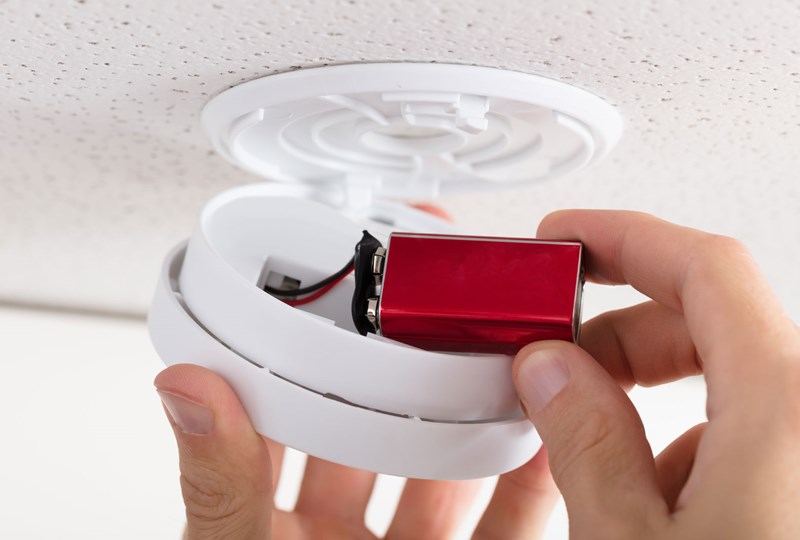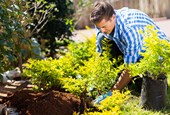
Key insights
- Routine maintenance is essential to preventing fires. Smoke detectors, furnace filters and gutters should all be checked regularly.
- Swap out potential fire hazards, like open flame candles, for safer alternatives in your home.
- Consult an expert if you have any questions regarding your home’s fire safety.
Whether you recently bought a new house or hope to increase the safety of your long-term residence, fire safety is essential. Moving forward, here are ten tips you can use to fireproof your home’s interior and exterior.
1. Install or check smoke detectors
Before assessing other fire hazards, be sure to check your smoke detectors. Make sure all detectors are installed and working properly. Then, set a calendar alert to re-check all alarms in your home monthly.
Not only is this the first step to creating a fireproof space, some home inspections check for smoke detectors, too.
2. Replace aging fire extinguishers
Have you had the same fire extinguisher for decades? Do you not have one at all? Conduct a monthly visual inspection to ensure it’s still in working order. Here’s how:
- See that your extinguisher is in its designated, accessible storage spot.
- Check that seals, indicators and other parts are free of damage.
- Note that the pressure gauge is in its suggested range.
Remember: In a fire emergency, every second will count! Experts recommend you keep an extinguisher on each level of your home, and another near your garage, for quick access.
3. Fireproof your grill and outdoor dining area
In the summer months, it can be especially easy for a fire to start from a barbecue or backyard grill. Be sure your grill is placed away from trees or shrubs and cut down overhanging branches to reduce your backyard fire risk.
Next, read labels carefully when decorating an inviting outdoor space to dine and hang out. While most new patio furniture will be fire-resistant, you may have to apply a flame retardant to older furniture.
4. Remove debris from gutters and roof areas
A fire can easily spark if embers happen to enter overflowing gutters — especially in dry conditions. Be sure to remove all debris from your gutters, roof, eaves and downspouts to minimize this risk.
Some quick tips to properly clean your gutters include:
- Removing clogs that could cause debris buildup.
- Disposing of leaves, twigs and other waste.
- Fixing cracks that could leak unwanted water into electrical systems.
5. Install fire-resistant carpeting and area rugs
Choosing the right rug for your space could require more than a simple question of color. If you’re replacing your carpets or rugs, consider buying one made from safer materials. Carpets and rugs made of wool or synthetic fibers tend to spread fire quickly, but fire-resistant carpets now exist in a variety of textures, colors and patterns.
Pay special attention to the material of hearth rugs or other floor coverings placed near a working fireplace, furnace or radiator.
6. Double-check electrical wiring
Be careful not to overload your wiring when adding a new device or appliance to your space. If you have older appliances that haven’t been looked at in recent months, move them from the wall to be sure the wiring isn’t frayed.
Not sure what to look for? Hire a professional electrician who can assess your wiring for a small fee.
7. Replace your furnace filter
To minimize your fire risk, it’s critical to conduct routine furnace maintenance, including replacing your filter regularly. A clogged filter can cause a furnace to overheat and potentially catch on fire. If you aren’t sure what maintenance your furnace requires, contact an HVAC expert or research your unit online to find the owner’s manual.
8. Clean your dryer’s lint trap
While there are plenty of new laundry hacks circulating the internet, there remain tried and true methods to take care of your dryer. If excess dust accumulates in your lint trap, it can eventually overheat and cause a fire.
Make it a habit to clean out your lint trap every time you use your dryer, and teach your roommates or children to do the same.
9. Replace old-school candles
According to the National Fire Protection Association, candles cause two percent of home fires, and that risk rises around the holidays.
If you’ve used candles to create a cozy home atmosphere in the past, try swapping out your open flames for these alternatives:
- Essential oil diffusers
- Reed diffusers
- Battery-operated candles
If you absolutely must use candles with flames, be sure to light them only if you will remain present (and awake!) in the room until it’s time for them to be extinguished.
10. Safely string lights
Whether hanging holiday lights or decorative strands, make sure you’re setting up your lights safely. Take these tips into consideration when hanging interior lights:
- Only purchase lights with nationally recognized seals of approval.
- Replace burnt-out bulbs with proper wattage and voltage.
- Check that string lights aren’t frayed.
- Keep hanging lights out of reach from little ones and pets – and away from heat sources.
- Use power strips to avoid overloading standard outlets.
One last tip before you go
Taking these precautions should help ease your mind about a potential house fire, but it’s important to be prepared should a fire emergency occur. Make a plan with everyone in your home to:
- Locate fire extinguishers and other safety instruments.
- Determine a place away from your home to meet if a fire starts.
- Contact officials in the event of an emergency.
Moving forward with other home safety measures? Be sure to contact the customer care team at Edina Realty or Edina Realty Insurance to protect your home and assets.









